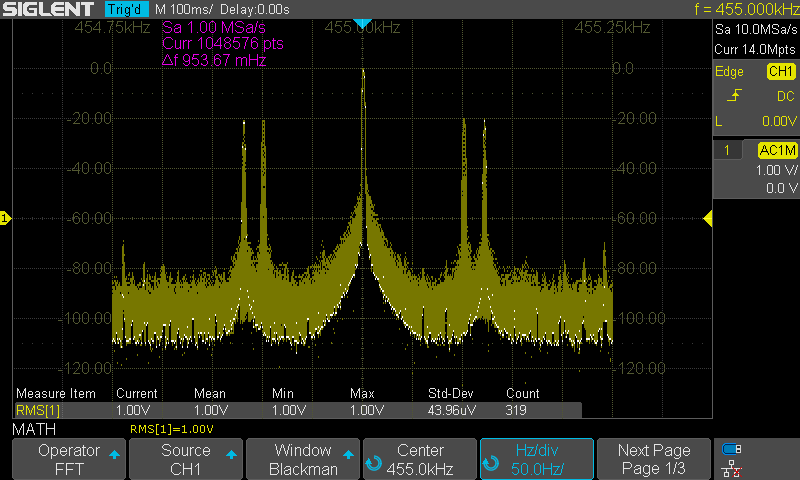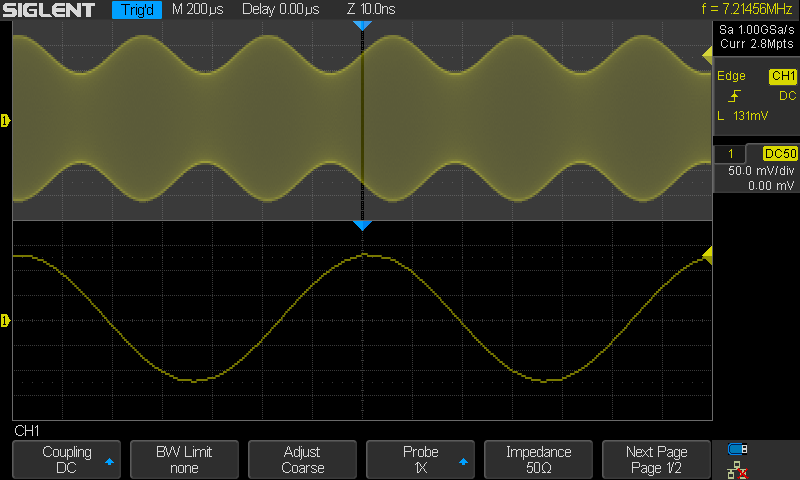Thanks for the replies. So is the memory depth not too big of a deal?
In terms of what I'd be measuring, yes I know that a spectrum analyser in many situations is more helpful but that is well outside by price range and also not so helpful for general electronics debugging, for instance I'm currently working on an oscillator which isn't working, but a scope would be helpful in seeing what's going on. I'm guessing that the FFT spectrum analyser feature of the scope could be very useful.
So the frequency analysis is better in the Siglent? That does seem like an important point. I missed that question as the details weren't on the spreadsheet!
Here is one FFT with SDS1202X-E.
Yes settings are not optimal at all if example looking 455kHz IF. This image just tell what it can also show.
White dots are average there and whole display used dots mode (because this image purpose was bit different)
Just turn dot mode off resolution etc is same.

Signal is 455kHz carrier modulated using dual tone 100Hz and 120Hz and modulation depth 20% (for noobs 20% is fun because only just this % sideband dBc have same number 20 (-20dBc)
There was used 10MSa/s for keep Nyquist enough high that example possible harmonics etc do not alias so much.
Of course also used capture length and time scale is well over what need and it is here making FFT slow.
With 10MSa/s 1Mpts FFT length give nice freq resolution for 0 - 5MHz band. (of course as can see freq axis is highly zoomed in from full span)
For radio things one important thing is memory length if look one thing. If we are looking (example) AM modulated signals we often want look it in time scale where modulating signal shape is visible and well stable with trig.
Memory lenght is not so important if we use right working peak detect mode for this but then we loose intensity gradation what is also part of information many times. Also then we loose carrier when sampling speed push fNyquist well under carrier. As most old DPO did if we look modulated signal bode.
If we set some imagined numbers. If we want look example 118MHz AM and modulated 100Hz and want we can see also real carrier and also this modulated shape. If think (for easy math) our display have 10 div horizontally. For one cycle 100Hz we need set time scale (aka timebase) to 1ms/div. Now then we have carrier 118MHz not so nice number so round it up to next full hundred 200MHz. Due to Mr Nyquist is here... we need least 400MSa/s ... oh but not... we need also level not only freq... and due to some reality... we need least 400MSa/s/0.8=500MSa/s. Now we have 2.5 sample over one 200MHz carrier cycle. Ok, well made Sinc interpolation can barely give ok looking result but of course more is better.
Now we have some minimum limit. We need 500MSa/s and we need take 10ms acquisition with this speed. 500x0.01=5. We need 5M memory for this if zero overlap.
With 5M memory we can keep 1ms/div (when whole length is 10ms) and 500MSa/s samplerate. With this we have up to 200MHz carrier and we have modulating frequency one cycle on screen when its frequency was 100Hz.
In this case we can use zoom window.. like dual timebase in analog scope... upper window modulated signal shape and bottom window 200MHz carrier sinewave.
This was minimum need for this. As can see memory is important for keep samplerate enough high even with slow time scale.
Of course there is many many other things but this was now looking somehow with radio things approach angle this thing.
In Siglent SDS1202X-E there is 14div in display time axis and max memory 14M so it is well enough for this kind of things. It can do it even with 2 channel on. 7M memory both and 500MSa/s both.

This is what I mean looking modulated shape and looking also carrier itself using zoom.
Do not look other things in this image. It is OLD and not at all from this model. This image was originally part of set for explain freq counter here.
Used carrier was 14MHz. There can see freq counter in right top corner. It need always remember this is not input signal frequency counter, never even designed for it!!! It is trigger freq counter, as can see... it counts in this case rising edges what meet user defined trig setup. Trig threshold is around half way in mod depth. So half is out from count.
But here this image purpose is only show what I mean looking AM shape and same time looking carrier itself.
Now if we have short memory where samplerate is dropped down well under Nyquist.. we get this upper part AM shape also if there is peak detect. But we loose this carrier wave.
Foe this kind of things in practice with 200MHz scope freq range for this purpose we can say we need least 5M memory if want go down to 100Hz Mod and still carrier available.
In this image trigger was done using just rising edge, threshold around half way AM depth and adjusted Trigger Holdoff time for get stable trig. This is simplest method but also very poor method. It is suitable only for around fixed Modulating freq. If modulating freq is changing we need much more clever trig and modern scope have it. One of very good trig function for this is Drop Out trig. Set trig mode Drop Out, Rising edge, trig level half of mod shape top and bottoms, Overtime Type Edge, Time 25us. And thats it.
Now if modulating freq change from around 100Hz up to even 20kHz you do not need adjust trigger at all... whole range it trig rock solid (until carrier or Mod
level change) If you use this poor old school Trigger Holdoff adjust you need adjust it frequently when Mod freq is changing.